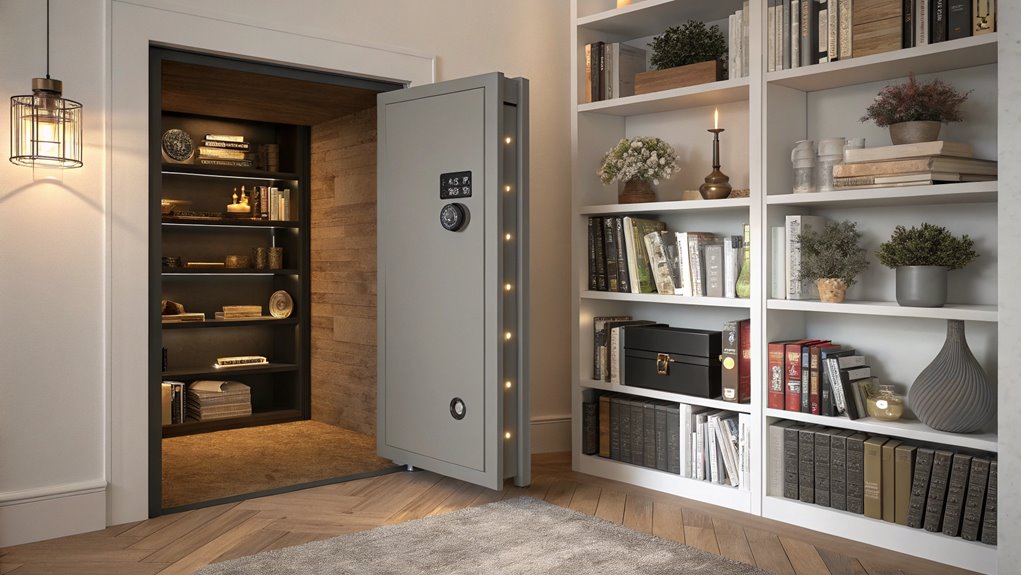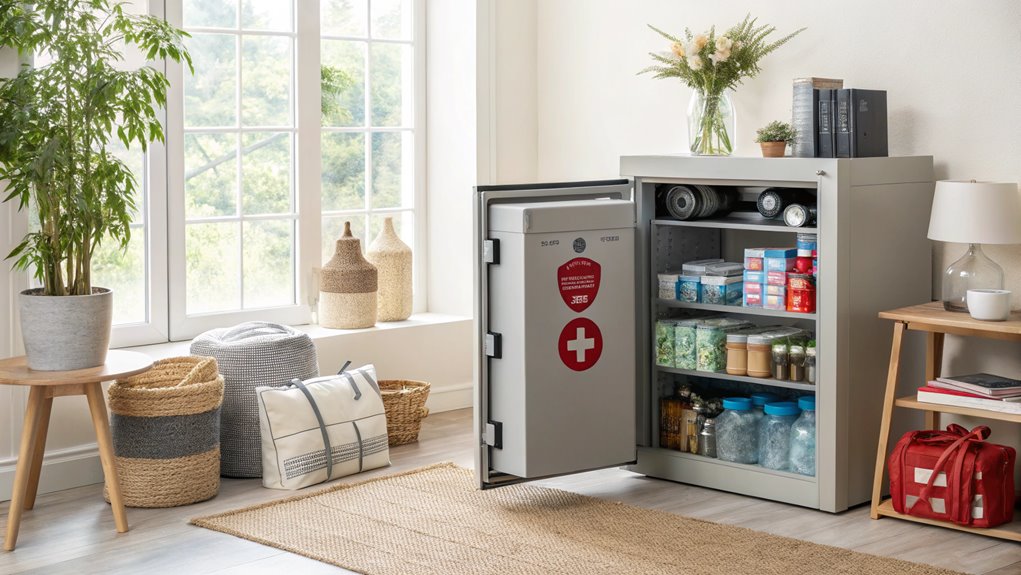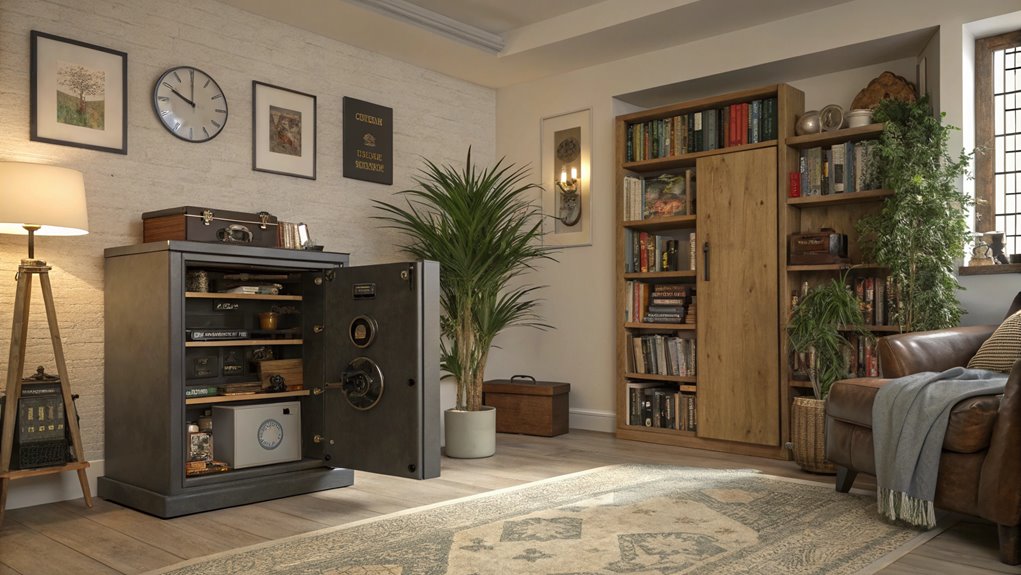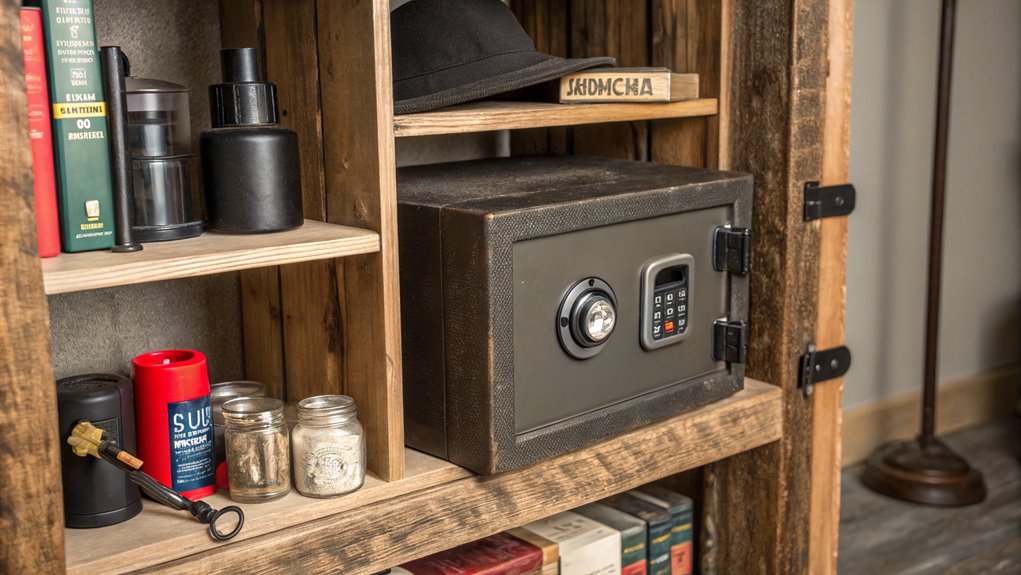
For Orders Over $25

On Any Of Our Products

Details On Refund Page
Hidden safes are super important for disaster preparedness because they help you get to your emergency gear and vital documents fast when things get chaotic. Imagine having hidden compartments in furniture or everyday objects, like books, where you can stash essentials such as first aid kits, food, and water. You'll want to pick a safe made of sturdy materials and place it somewhere easily accessible, like a false outlet or under a removable panel. This way, you've got quick access to what you need. Stay ahead of potential crises, and you'll be better prepared for anything life throws at you! There's a lot more to explore on this topic.

When it comes to disaster preparedness, hidden safes can be a game changer. You might think of them only as places to hide valuables, but they're so much more than that.
Imagine needing quick access to your emergency kits during a crisis. A hidden safe lets you store essential supplies—like first aid items, food, water, and important documents—while keeping them out of sight from prying eyes. Cola Can Safes offer a discreet design that blends seamlessly with household items, making them ideal for such purposes.
Using safe materials for your hidden safe is vital. You want something sturdy that can withstand wear and tear, especially in emergencies. Think about a safe that blends seamlessly into your home; you don't want to draw attention to your supplies.
Plus, when disaster strikes, you don't have time to search high and low for your emergency kits. Instead, you can open your hidden safe and grab what you need in seconds.
It's all about being prepared, and having those essentials—like a flashlight, batteries, or a portable phone charger—within arm's reach can mean the difference between chaos and control. Consider using a Coors Light Can Safe for its discreet design and security benefits, making it an ideal choice for keeping emergency items hidden yet accessible.
Hidden safes come in various types, each designed to blend in seamlessly with your home environment. You might find hidden compartments in everyday objects, like books or wall art, which can hold your emergency supplies without drawing attention. These clever designs let you store important items while keeping them out of sight from prying eyes.
Another popular option is disguised furniture, like ottomans or coffee tables, that have built-in storage. These pieces not only serve a functional purpose but also provide a safe place for your supplies.
You could also consider using false electrical outlets or air vents, which can be great for stashing small items that you want to keep secure.
Finally, think about utilizing your kitchen. Some kitchen appliances have hidden spaces, and you can even buy fake food containers designed specifically for storing valuables, such as the Water Bottle Diversion Safe, which mimics a standard drinking bottle for discreet storage.
The key to an effective hidden safe is ensuring it's something you regularly interact with, making it easy to access your emergency supplies when you need them most.

One key benefit of using hidden safes for disaster preparedness is that they offer discreet storage for essential supplies. Imagine needing emergency supplies during a crisis but not being able to find them quickly!
Hidden safes keep your items out of sight while ensuring they're always accessible when you need them most. This is especially important during safety planning, where every second counts.
When you store things like food, water, first-aid kits, or important documents in a hidden safe, you're not just hiding them; you're protecting them. In a disaster, it's vital to have a plan, and knowing where your emergency supplies are can make all the difference.
Plus, hidden safes can deter thieves, meaning your supplies are safer from theft when you're away from home or during a crisis.
Selecting the right safe for your disaster preparedness needs involves considering various factors to guarantee it meets your specific requirements.
First, think about safe materials. You want a safe made of sturdy steel or some fire-resistant materials to protect your important documents and valuables from fire or water damage during a disaster.
Next, consider safe sizes. You don't want to end up with a safe that's too small to fit everything you need, like emergency cash, identification, and other essentials. On the other hand, a safe that's too big could be harder to hide and access quickly.
You should also think about how many items you plan to store. If you have a lot of important documents, a larger safe might be necessary, while a smaller one could do if you only need to store a few items.
Don't forget to check the locking mechanism, too; it should be reliable and easy for you to use but tough for anyone else.

After choosing the right safe, the next step is determining where to place it for maximum effectiveness. Think about safe locations that are both discreet and strategic. You want it hidden enough to deter thieves but still accessible when you need it most. Here are a few accessibility strategies to contemplate:
| Safe Location | Pros | Cons |
|---|---|---|
| Under the floorboards | Hidden and secure | Difficult to access quickly |
| Inside a wall cavity | Out of sight | May require tools to reach |
| In a false electrical outlet | Very discreet | Limited space for items |
| Behind a removable panel | Quick access | May not blend with decor |
When deciding, remember to reflect on who might need to access it in an emergency. You don't want to be fumbling around when seconds count. Also, think about the weight of your safe. If it's too heavy to move quickly, you might want to rethink its placement. Ultimately, finding the right balance between concealment and accessibility is key to ensuring your safe truly serves its purpose during a disaster.
When it comes to equipping your safe for disaster preparedness, knowing what to store inside is vital. Start with your essential documents, like birth certificates, passports, and insurance policies. These items can be significant in emergencies when you need to prove your identity or access assistance.
Don't forget about important medical records that could help in crisis situations.
Next, think about emergency supplies. You might want to store a small stash of cash, as ATMs and credit card systems could go down during a disaster. Include a flashlight, a whistle, and some batteries to keep you safe and informed.
If space allows, consider adding a first-aid kit; it's always better to be prepared for cuts, scrapes, or worse. You could also stash a portable phone charger to help you stay connected.
Finally, keep a list of all the items in your safe and review it regularly. This guarantees you know exactly what you have, and it'll save you time when you really need it.

Maintaining your safe is essential for guaranteeing its security and functionality over time. You don't want to wait until a disaster strikes to realize your safe is malfunctioning or, worse, that someone could easily break into it. Start with regular checks to guarantee everything's working smoothly; this includes testing the lock and guaranteeing there's no rust or wear on the hinges.
Consider routine safe maintenance as part of your safety plan. Depending on the type of safe you have, it might require occasional oiling or cleaning to keep it in top shape.
It's also a good idea to update the combination or password regularly; think of it like changing your online passwords to keep your information secure.
You might even want to look into security upgrades, like adding a backup lock or a biometric option. These can add an extra layer of protection, making it harder for anyone to access your valuables without your permission.
Yes, hidden safes can protect against fire and water damage when they're made with fireproof materials and waterproof designs. You'll guarantee your valuables stay safe, even in the most challenging conditions.
Imagine you're in an old-timey bank, eyeing a hidden safe. When it comes to safe pricing, you'll find costs range from $100 to $1,000, so budget considerations are key for your purchase decisions.
To create a secret access point for your safe, consider installing concealed entrances or building secret compartments in furniture. These methods disguise your safe while providing easy access whenever you need it. Get creative with designs!
Think of installation methods as a puzzle; some pieces fit easily, while others might need professional assistance. If you're handy, you can tackle it yourself, but don't hesitate to call for help if you're unsure.
When choosing materials for a hidden safe, consider steel vs wood. Steel offers superior durability and security, while wood blends better with home aesthetics. Your choice depends on your priorities—protection or appearance.
So, when disaster strikes, having a hidden safe isn't just a clever idea—it's a smart move to keep your important stuff out of harm's way. Whether you choose a book safe or a wall compartment, it's all about being prepared and staying one step ahead. Don't wait for the unexpected to catch you off guard; stash away those essentials and breathe easy knowing you've got a plan. Remember, a little foresight goes a long way!

I’ve been a dedicated advocate in the non-lethal self defense industry providing pepper spray, stun guns personal alarms, batons and more. I started my journey in the early ‘90s. My goal is to ensure that everyone has access to the right tools for their safety and peace of mind. Before the internet, I sold door to door with flyers in residential areas and then to bars, nightclubs, flea markets, home parties, schools, security companies, dojos, and more. As a former counselor, I’ve also teamed up with women’s shelters and college campus safety teams, striving to make a meaningful difference in countless lives.